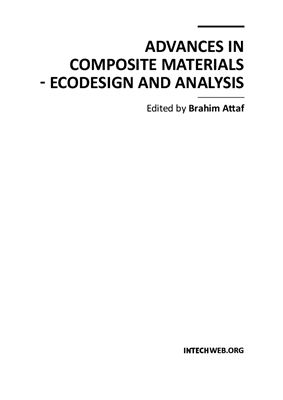InTech. 2011. 654 p.
By adopting the principles of sustainable design and cleaner production, this important book opens a new challenge in the world of composite materials and explores the achieved advancements of specialists in their respective areas of research and innovation. Contributions coming from both spaces of academia and industry were so diversified that the 28 chapters composing the book have been grouped into the following main parts: sustainable materials and ecodesign aspects, composite materials and curing processes, modelling and testing, strength of adhesive joints, characterization and thermal behaviour, all of which provides an invaluable overview of this fascinating subject area. Results achieved from theoretical, numerical and experimental investigations can help designers, manufacturers and suppliers involved with high-tech composite materials to boost competitiveness and innovation productivity.
Contents
Part 1 Sustainable Materials and Ecodesign Aspects
Generation of New Eco-friendly Composite Materials via the Integration of Ecodesign Coefficients
Design, Manufacture and Performance Evaluation of Non-Asbestos Sealing Composites
Thermoplastic Polymer based Modified Red Mud Composites Materials
Biopolymer as Reinforcement into Natural Matrices: a New Route to Bio-Composite Materials
Properties of Polymer Composites with Cellulose Microfibrils
Part 2 Composite Materials and Curing Processes
Radiation Curing of Thermosetting-Thermoplastic Blends as Matrices for Structural Carbon Fibre Composites
Optimization of Curing Cycles for Thick-wall Products of the Polymeric Composite Materials
Development of 3D Knitted Fabrics for Advanced Composite Materials
Part 3 Modelling and Testing of Composites
To Carry Out Tolerance Analysis of an Aeronautic Assembly Involving Free Form Surfaces in Composite Material
Application of Optical Fibre Sensors to Measuring the Mechanical Properties of Composite Materials and Structures
Cost Effective Computational Approach for Generation of Polymeric Composite Material Allowables for Reduced Testing
Elaboration and Properties of Carbon Fibre Reinforced Copper Matrix Composites
Engineering, Modeling and Testing of Composite Absorbing Materials for EMC Applications
Radioactivity Control of Composite Materials Using Low Energy Photon Radiation
Dynamic Responses of Composite Structures with Fluid-Structure Interaction
Experimental Investigation
of Dynamic Compression and Damage Kinetics of Glass/Epoxy Laminated Composites under High Strain Rate Compression
Buckling and Post-buckling Analysis of Composite Plates
Finite Element Analysis of Delamination Growth in Composite Materials using LS-DYNA: Formulation and Implementation of New Cohesive Elements
Finite Element Analysis of Progressive Degradation versus Failure Stress Criteria on Composite Damage Mechanics
Bonded Composite Patch Repairs on Cracked Aluminum Plates: Theory, Modeling and Experiments
Part 4 Stress-strength Analysis of Adhesive Joints
Strength of Composite Scarf Joints
Design and use of a Fatigue Test Machine in Plane Bending for Composite Specimens and Bonded Joints
On the Behavior of FRP-to-concrete Adhesive Interface: Theoretical Models and Experimental Results
Part 5 Characterization and Thermal Behaviour
Estimation of the Degree of Anisotropy and Overall Elastic Stiffness of Advanced Anisotropic Materials
Lightweight Unfolded Composite Materials Acquiring Stability of the Shape due to Factors of Space Environment
G40-800/5260 Carbon Fiber/Bismaleimide Composite Material: High Temperature Characteristics of Static and Fatigue Strengths
Self-Consistent Micromechanical Enhancement of Continuous Fiber Composites
The Effective Thermal Transport in Composite Materials
By adopting the principles of sustainable design and cleaner production, this important book opens a new challenge in the world of composite materials and explores the achieved advancements of specialists in their respective areas of research and innovation. Contributions coming from both spaces of academia and industry were so diversified that the 28 chapters composing the book have been grouped into the following main parts: sustainable materials and ecodesign aspects, composite materials and curing processes, modelling and testing, strength of adhesive joints, characterization and thermal behaviour, all of which provides an invaluable overview of this fascinating subject area. Results achieved from theoretical, numerical and experimental investigations can help designers, manufacturers and suppliers involved with high-tech composite materials to boost competitiveness and innovation productivity.
Contents
Part 1 Sustainable Materials and Ecodesign Aspects
Generation of New Eco-friendly Composite Materials via the Integration of Ecodesign Coefficients
Design, Manufacture and Performance Evaluation of Non-Asbestos Sealing Composites
Thermoplastic Polymer based Modified Red Mud Composites Materials
Biopolymer as Reinforcement into Natural Matrices: a New Route to Bio-Composite Materials
Properties of Polymer Composites with Cellulose Microfibrils
Part 2 Composite Materials and Curing Processes
Radiation Curing of Thermosetting-Thermoplastic Blends as Matrices for Structural Carbon Fibre Composites
Optimization of Curing Cycles for Thick-wall Products of the Polymeric Composite Materials
Development of 3D Knitted Fabrics for Advanced Composite Materials
Part 3 Modelling and Testing of Composites
To Carry Out Tolerance Analysis of an Aeronautic Assembly Involving Free Form Surfaces in Composite Material
Application of Optical Fibre Sensors to Measuring the Mechanical Properties of Composite Materials and Structures
Cost Effective Computational Approach for Generation of Polymeric Composite Material Allowables for Reduced Testing
Elaboration and Properties of Carbon Fibre Reinforced Copper Matrix Composites
Engineering, Modeling and Testing of Composite Absorbing Materials for EMC Applications
Radioactivity Control of Composite Materials Using Low Energy Photon Radiation
Dynamic Responses of Composite Structures with Fluid-Structure Interaction
Experimental Investigation
of Dynamic Compression and Damage Kinetics of Glass/Epoxy Laminated Composites under High Strain Rate Compression
Buckling and Post-buckling Analysis of Composite Plates
Finite Element Analysis of Delamination Growth in Composite Materials using LS-DYNA: Formulation and Implementation of New Cohesive Elements
Finite Element Analysis of Progressive Degradation versus Failure Stress Criteria on Composite Damage Mechanics
Bonded Composite Patch Repairs on Cracked Aluminum Plates: Theory, Modeling and Experiments
Part 4 Stress-strength Analysis of Adhesive Joints
Strength of Composite Scarf Joints
Design and use of a Fatigue Test Machine in Plane Bending for Composite Specimens and Bonded Joints
On the Behavior of FRP-to-concrete Adhesive Interface: Theoretical Models and Experimental Results
Part 5 Characterization and Thermal Behaviour
Estimation of the Degree of Anisotropy and Overall Elastic Stiffness of Advanced Anisotropic Materials
Lightweight Unfolded Composite Materials Acquiring Stability of the Shape due to Factors of Space Environment
G40-800/5260 Carbon Fiber/Bismaleimide Composite Material: High Temperature Characteristics of Static and Fatigue Strengths
Self-Consistent Micromechanical Enhancement of Continuous Fiber Composites
The Effective Thermal Transport in Composite Materials

